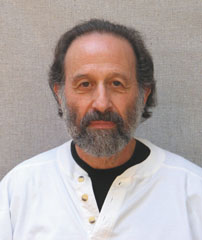 |
 |
Robert |
|
|
Robert Chuckrow (MCKA) began his study of Kinetic Awareness® with Elaine Summers in 1974 and continued his association with her until her passing. He has studied T’ai Chi, Ch’i Kung, and other movement, self-development, and healing arts since 1970 under other masters including Cheng Man-ch’ng, William C.C. Chen, Alice Holtman, Harvey I. Sober, Kevin Harrington, and Chin Fan-siong. He has taught T’ai Chi extensively and has authored six books, one on diet, one on the historical tuning of keyboard instruments, and four on T’ai Chi. His Ph.D. is in experimental physics from New York University, and he has taught physics for a total of 43 years (at NYU, The Cooper Union, and Fieldston School in Riverdale, NY). His last two books, Tai Chi Dynamics and Tai Chi Concepts and Experiments contain results of his research into what Elaine termed Extension Tension and provide what Elaine wanted—an attempt at understanding its scientific basis. Also, Chuckrow’s teaching utilizes many KA® concepts including physiologically correct alignment of spine, knees, ankles, and feet; meditative stretching; movement initiation; independence of movement; self-massage; and various relaxation, breathing, and vision exercises. Chuckrow’s teaching emphasizes an understanding and attainment of natural movement, health, and self-development. Individual classes are offered for those seeking alignment reeducation utilizing KA® principles.
|
||||||
|
by Robert Chuckrow, Ph.D. Click cover to view back cover
Tai Chi Concepts and Experiments clarifies and makes accessible critical aspects of the art that only a small number of high-level practitioners currently understand and manifest. Numerous step-by-step experiments are provided for readers to experience and perfect these critical tai chi aspects: Contents include:• The meaning and importance of releasing tension in movement for stability, health, and spirituality. • The differences between contractive and expansive strength including a promising mechanism for the nature of expansive strength. • Numerous experiments for readers to recognize and experience expansive strength and to confirm that they have achieved it. • Elucidation of famous master’s sayings on mind, strength, and ch’i. • Health and martial advantages of expansion over contraction in T’ai Chi. • Protocols using expansion including those for helping an excess curvature of the upper and lower spine and for relieving plantar fasciitis. • Quotes from the classics and how they confirm the interpretations of the principles of T’ai Chi. • How to achieve optimal balance through an understanding of physical, anatomical, physiological, and mental factors. • A detailed analysis of “rooting and redirecting” including physical and internal aspects. • Understanding natural movement from physical, philosophical, health, and martial points of view. This award-winning, interdisciplinary book utilizes, elementary physics, physiology, anatomy, psychology, and spirituality. It includes detailed analyses, explanations, and reader-experiments for achieving internal, expansive strength, known as nei jin, and for attaining optimal timing and natural movement. This 220-page book is Now available. Purchase Tai Chi Concepts and Experiments from YMAA Publication Center Purchase Tai Chi Concepts and Experiments from Amazon.com What is said about Tai Chi Concepts and Experiments
by Robert Chuckrow, Ph.D. Click cover to view image of back cover    Tai Chi Dynamics received an honorable mention in the Independent Publisher Book Awards in the martial arts / alternative health category, won the Best-Book Award in health: exercise and fitness from USA Book News, won the Eric Hoffer Book Award for excellence in independent publishing, and was a finalist in Foreword Magazine’s Book of the Year Award. It is intended for intermediate and advanced Taiji players. The author, a Taiji practitioner since 1970 and whose Ph.D. is in experimental physics, applies logic and basic scientific principles of anatomy, physiology, and physics to muscular action, breathing, and alignment in Taiji movement and push-hands. He clarifies, in depth, many perplexing concepts such as “correct force” by utilizing detailed explanations, illustrations, and photographs. Sayings from the Taiji Classics are quoted throughout, and exercises are provided to give readers a chance to confirm their understanding. Over a dozen self-defense applications of the basic Taiji movements are illustrated, and the effectiveness and completeness of Taiji as a martial art today is candidly analyzed. One chapter on teaching Taiji, stemming from over three decades of practical experience, ranges from suggestions on how to advertise and start a beginners’ class to class management to legal and financial aspects. A chapter on the late Zheng Manqing (Cheng Man-ch’ing), with whom the author studied for five years in the early 1970s, sheds light on Zheng and his students. One chapter deals extensively with aspects of self development from a personal perspective, discusses how doing Taiji correctly is a precursor to spiritual growth, and compares religion, science, and spiritual teachings. A detailed chapter on health, self-massage, and healing discusses fasting (including the author’s own experience with a twenty-eight-day fast), analyzes differences between Traditional Chinese Medicine and Western Medicine, and provides exercises and methods of self-massage for head, legs, feet, and back. There is even a section on how to make your own footwear suitable for practicing Taiji. The book has 252 pages, includes personal anecdotes and stories, and has dozens of illustrations drawn by the author and over ninety photographs. Purchase Tai Chi Dynamics from Amazon.com |
||||||






